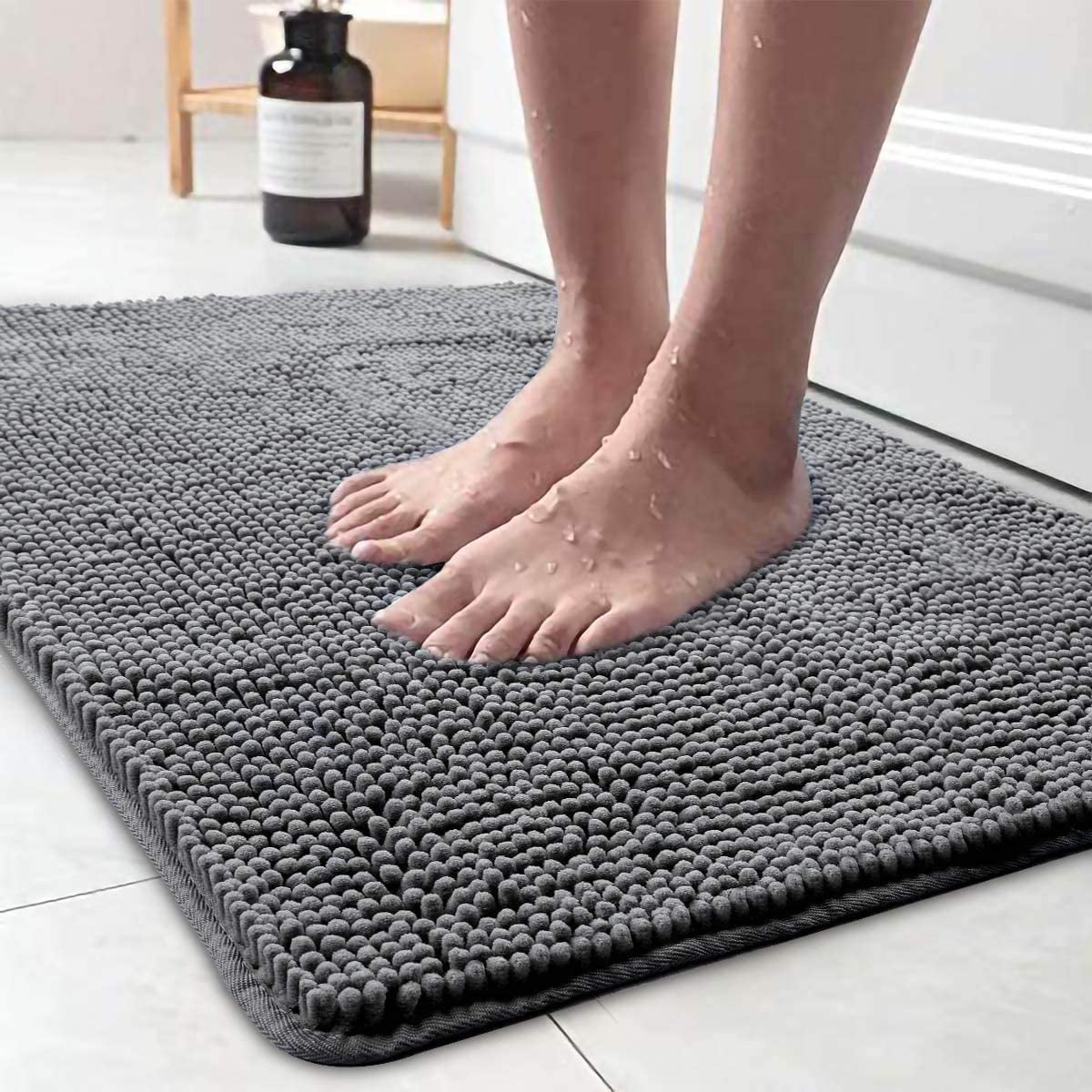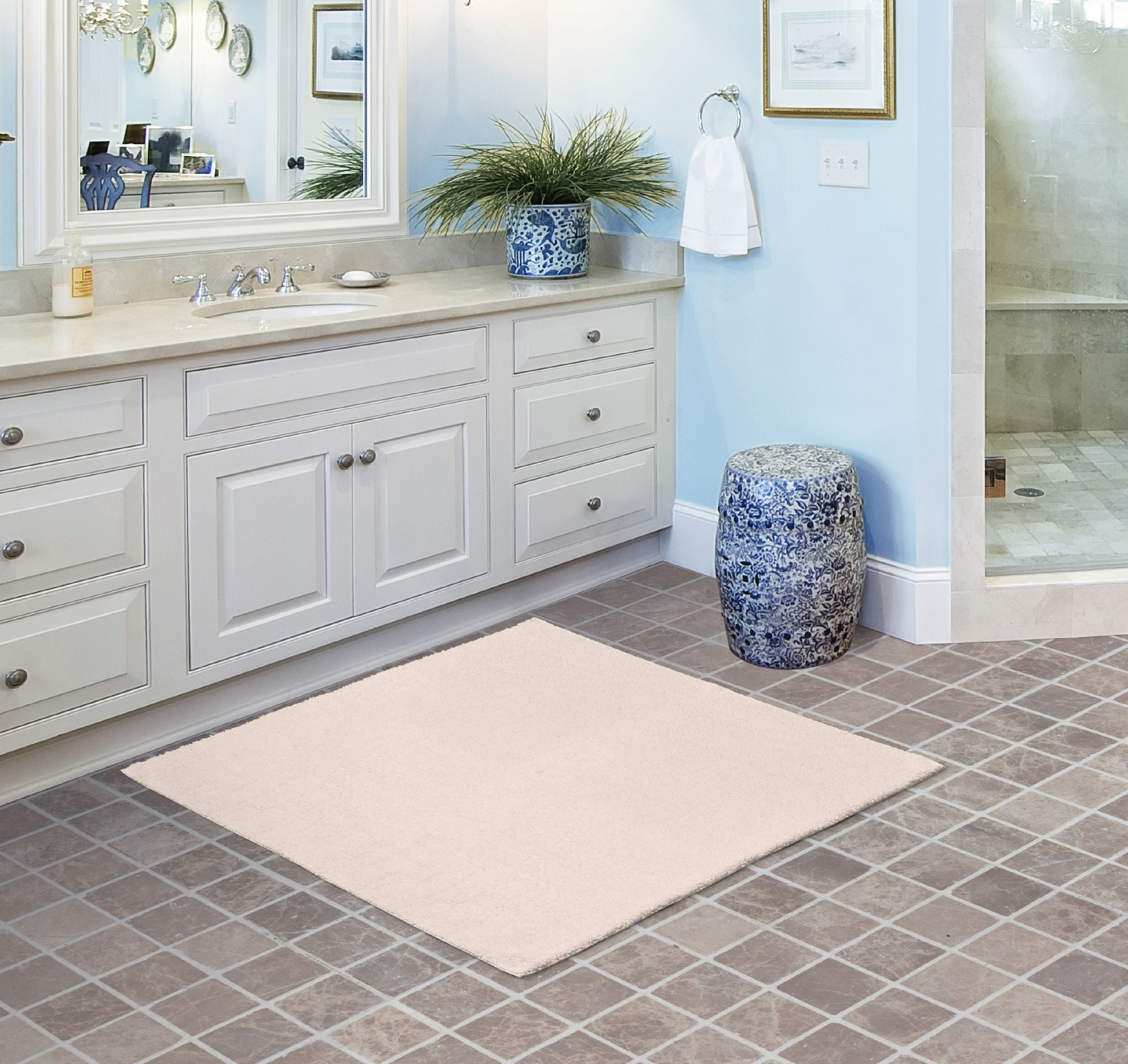Benefits of Non-Rubber Backed Bathroom Rugs

Non-rubber backed bathroom rugs offer a refreshing alternative to traditional rubber-backed options, providing a range of advantages that cater to diverse needs and preferences. While rubber-backed rugs excel in their ability to prevent slipping, non-rubber backed rugs prioritize other qualities, making them ideal for specific individuals and situations.
Material Advantages of Non-Rubber Backed Bathroom Rugs, Non rubber backed bathroom rugs
Non-rubber backed rugs are crafted from a variety of materials, each possessing unique characteristics that contribute to their overall appeal. These materials offer distinct benefits that enhance the overall bathroom experience.
- Cotton: Known for its softness and absorbency, cotton is a popular choice for bathroom rugs. Its natural fibers provide a comfortable and plush feel underfoot, effectively absorbing moisture and drying quickly. Cotton rugs are also breathable, preventing the growth of mold and mildew, particularly in humid environments.
- Microfiber: Microfiber rugs are renowned for their exceptional absorbency, effectively wicking away water and drying rapidly. Their dense, fine fibers create a soft and luxurious feel, while their durability ensures long-lasting use. Microfiber rugs are also machine-washable, making them convenient and easy to maintain.
- Bamboo: Bamboo rugs are a sustainable and eco-friendly option, offering a natural and elegant aesthetic. Their unique texture provides a soft and comfortable feel underfoot, while their inherent antimicrobial properties discourage the growth of bacteria and mold. Bamboo rugs are also naturally moisture-wicking, ensuring a dry and hygienic bathroom environment.
Types of Non-Rubber Backed Bathroom Rugs

Non-rubber backed bathroom rugs are a popular choice for many homeowners, offering a wide range of styles, materials, and designs to suit diverse preferences. These rugs provide a soft and comfortable surface to step onto after a shower or bath, adding a touch of elegance and personality to the bathroom space. Let’s explore the different types of non-rubber backed bathroom rugs, understanding their unique characteristics and suitability for specific bathroom environments.
Types of Non-Rubber Backed Bathroom Rugs Based on Material
The choice of material for a non-rubber backed bathroom rug plays a crucial role in its functionality, durability, and aesthetics. Let’s delve into the most common types of materials used in these rugs:
- Cotton: Cotton is a natural, soft, and absorbent material, making it an excellent choice for bathroom rugs. It’s breathable, hypoallergenic, and easy to care for. Cotton rugs are generally lightweight and readily available in a variety of colors and patterns. However, they tend to be less durable than other materials, prone to shrinkage, and require frequent washing.
- Microfiber: Microfiber rugs are known for their exceptional absorbency, softness, and durability. They are quick-drying, resistant to stains and mildew, and relatively easy to clean. Microfiber rugs come in various textures and designs, offering a wide range of options to complement any bathroom décor.
- Wool: Wool is a natural fiber known for its warmth, softness, and durability. Wool rugs are naturally water-resistant and stain-resistant, making them an excellent choice for high-traffic areas. They also have excellent moisture-wicking properties, keeping the bathroom floor dry. However, wool rugs can be more expensive than other options and require specialized cleaning.
- Bamboo: Bamboo is a sustainable and eco-friendly material that is increasingly popular for bathroom rugs. It’s naturally antimicrobial and hypoallergenic, making it a good choice for people with sensitivities. Bamboo rugs are also durable, breathable, and water-resistant. However, they can be more expensive than other options and may require specialized cleaning.
- Jute: Jute is a natural fiber known for its durability and sustainability. It’s a good choice for bathroom rugs as it’s water-resistant and can withstand heavy foot traffic. Jute rugs are also eco-friendly and biodegradable. However, they can be rougher than other materials and may require specialized cleaning.
Characteristics and Properties of Non-Rubber Backed Bathroom Rugs
The choice of material for a non-rubber backed bathroom rug directly influences its characteristics and properties, impacting its suitability for specific bathroom environments.
| Rug Type | Material | Pros | Cons |
|---|---|---|---|
| Cotton | Natural, soft, absorbent | Breathable, hypoallergenic, easy to care for | Less durable, prone to shrinkage, requires frequent washing |
| Microfiber | Synthetic, soft, absorbent | Quick-drying, stain and mildew resistant, easy to clean | May shed fibers, not as natural as cotton |
| Wool | Natural, warm, soft | Water-resistant, stain-resistant, moisture-wicking | More expensive, requires specialized cleaning |
| Bamboo | Natural, sustainable, antimicrobial | Durable, breathable, water-resistant | More expensive, may require specialized cleaning |
| Jute | Natural, durable, sustainable | Water-resistant, eco-friendly, biodegradable | Rougher than other materials, may require specialized cleaning |
Care and Maintenance of Non-Rubber Backed Bathroom Rugs: Non Rubber Backed Bathroom Rugs

Proper care and maintenance are crucial for extending the lifespan of your non-rubber backed bathroom rugs and preserving their beauty. These rugs are susceptible to moisture, dirt, and wear and tear, so it’s important to follow a consistent cleaning routine.
Cleaning Methods for Different Rug Materials
The cleaning method you choose will depend on the material of your rug. Here’s a guide for cleaning various types of non-rubber backed bathroom rugs:
- Cotton Rugs: Cotton rugs are generally easy to care for and can be machine-washed on a gentle cycle with cold water. However, it’s recommended to use a mild detergent and avoid using bleach, which can damage the fibers. After washing, air dry the rug flat or hang it to dry. Avoid putting it in a dryer, as the heat can shrink the cotton.
- Wool Rugs: Wool rugs are more delicate and require a gentle approach. Hand washing with a mild detergent is the preferred method. Avoid soaking the rug for extended periods, as this can damage the fibers. Rinse thoroughly and gently squeeze out excess water. Air dry the rug flat, away from direct sunlight, which can fade the colors. For stubborn stains, consider using a specialized wool rug cleaner.
- Jute Rugs: Jute rugs are known for their natural texture and durability. However, they are susceptible to water damage, so it’s important to spot clean them as needed. Use a damp cloth with a mild detergent to clean any spills or stains. Avoid soaking the rug, as this can cause it to shrink or warp. Air dry the rug flat in a well-ventilated area.
- Bamboo Rugs: Bamboo rugs are known for their natural elegance and durability. They are generally easy to clean and can be swept or vacuumed regularly. For deeper cleaning, use a damp cloth with a mild detergent to spot clean any stains. Avoid soaking the rug, as this can damage the bamboo fibers. Air dry the rug flat in a well-ventilated area.
Stain Removal Tips
- Fresh Stains: For fresh stains, blot the area immediately with a clean cloth or paper towel to absorb as much of the stain as possible. Avoid rubbing the stain, as this can push it deeper into the fibers.
- Dried Stains: For dried stains, you can try using a mild detergent mixed with water to create a cleaning solution. Apply the solution to the stain and let it sit for a few minutes before gently scrubbing with a soft-bristled brush. Rinse the area thoroughly with clean water and air dry the rug flat.
- Stubborn Stains: For stubborn stains, you may need to use a specialized stain remover. Be sure to test the stain remover on a hidden area of the rug first to ensure it doesn’t damage the fibers. Follow the instructions on the stain remover product carefully.
Odor Control
- Regular Cleaning: Regular cleaning is essential for preventing odors from building up in your non-rubber backed bathroom rug. Vacuum the rug regularly to remove dirt and debris.
- Baking Soda: Baking soda is a natural deodorizer and can help absorb odors from your rug. Sprinkle baking soda over the rug, let it sit for a few hours, and then vacuum it up.
- Vinegar: Vinegar is another natural deodorizer and can help remove unpleasant odors. Mix equal parts white vinegar and water in a spray bottle. Spray the solution over the rug, let it sit for a few minutes, and then air dry the rug flat.
Importance of Regular Cleaning and Drying
Regular cleaning and drying are essential for preventing mold and mildew growth in your non-rubber backed bathroom rug. Mold and mildew thrive in damp environments, so it’s important to dry the rug thoroughly after each use. If you notice any signs of mold or mildew, clean the rug immediately with a solution of bleach and water.
Non rubber backed bathroom rugs – Non-rubber backed bathroom rugs offer a stylish alternative to traditional options, providing a softer feel underfoot and a more contemporary aesthetic. While these rugs may require more frequent cleaning due to their lack of a waterproof backing, they can be paired with complementary bathroom accessories, such as valentine bathroom hand towels , to create a cohesive and inviting ambiance.
The absence of a rubber backing also allows for greater versatility in rug placement, as they can be used on a variety of surfaces without the risk of slipping or damage.
Non-rubber backed bathroom rugs offer a variety of benefits, including a more elegant aesthetic and improved breathability. While some may find them less secure than their rubber-backed counterparts, a solution lies in choosing flat rugs specifically designed for bathroom use, which often feature materials like microfiber or cotton that resist slipping.
Flat rugs for bathrooms provide both style and functionality, ensuring a safe and stylish addition to your bathroom decor, even without the traditional rubber backing.